Numerical Study of the Normal Impinging Water Jet at Different Impinging Height, Based on Wray–Agarwal Turbulence Model
Abstract
1. Introduction
2. Computational Model
2.1. Geometric Model and Boundary Conditions
2.2. Mesh Information
2.3. Wray–Agarwal Turbulence Model
3. Results and Discussion
3.1. Analysis of Vertical Submerged Jet Flow Field under Different Impinging Heights
3.2. Time-Averaged Impinging Pressure Distribution
4. Conclusions
Author Contributions
Funding
Conflicts of Interest
References
- Cooper, D.; Jackson, D.C.; Launder, B.E.; Liao, G.X. Impinging jet studies for turbulence model assessment-I. Flow-field experiments. Int. J. Heat Mass Transfer. 1993, 36, 2675–2684. [Google Scholar] [CrossRef]
- Naib, S.A.; Sanders, J. Oblique and Vertical Jet Dispersion in Channels. J. Hydraul. Eng. 1997, 123, 456–462. [Google Scholar] [CrossRef]
- Wang, C.; Wang, X.; Shi, W.; Lu, W.; Ling, Z. Experimental Investigation on Impingement of a Submerged Circular Water Jet at Varying Impinging Angles and Reynolds Numbers. Exp. Therm. Fluid Sci. 2017, 89, 189–198. [Google Scholar] [CrossRef]
- Krishnan, G.; Mohseni, K. An experimental study of a radial wall jet formed by the normal impingement of a round synthetic jet. Eur. J. Mech. B-Fluid. 2010, 29, 269–277. [Google Scholar] [CrossRef]
- Shestakov, M.V.; Dulin, V.M.; Tokarev, M.P.; Sikovsky, D.P.; Markovich, D.M. PIV study of large-scale flow organisation in slot jets. Int. J. Heat Fluid Flow. 2015, 51, 335–352. [Google Scholar] [CrossRef]
- Lu, Z.; Lu, Y.; Xia, B.; Liu, Y.; Zhao, L.; Ge, Z.; Zuo, W. Numerical simulation on hydrodynamic characteristics of percussion pulsed jet. J. China Univ. Pet. Ed. Nat. Sci. 2013, 37, 104–108. [Google Scholar]
- Craft, T.J.; Graham, L.J.W.; Launder, B.E. Impinging jet studies for turbulence model assessment—II. An examination of the performance of four turbulence models. Int. J. Heat Mass Transfer. 1993, 36, 2685–2697. [Google Scholar] [CrossRef]
- Baughn, J.W.; Shimizu, S. Heat transfer measurements from a surface with uniform heat flux and an impinging jet. J. Heat Transfer. 1989, 111, 1096–1098. [Google Scholar] [CrossRef]
- Gutmark, E.; Wolfshtein, M.; Wygnanski, I. The plane turbulent impinging jet. J. Fluid Mech. 1978, 88, 737–756. [Google Scholar] [CrossRef]
- Wang, C.; Chen, X.; Qiu, N.; Zhu, Y.; Shi, W. Numerical and experimental study on the pressure fluctuation, vibration, and noise of multistage pump with radial diffuser. J. Braz. Soc. Mech. Sci. Eng. 2018, 40, 481. [Google Scholar] [CrossRef]
- Wang, H.; Long, B.; Wang, C.; Han, C.; Li, L. Effects of the Impeller Blade with a Slot Structure on the Centrifugal Pump Performance. Energies 2020, 13, 1628. [Google Scholar] [CrossRef]
- Shi, L.; Zhu, J.; Tang, F.; Wang, C. Multi-disciplinary optimization design of axial-flow pump impellers based on the approximation model. Energies 2020, 13, 779. [Google Scholar] [CrossRef]
- He, X.; Zhang, Y.; Wang, C.; Zhang, C.; Cheng, L.; Chen, K.; Hu, B. Influence of critical wall roughness on the performance of double-channel sewage pump. Energies 2020, 13, 464. [Google Scholar] [CrossRef]
- Wang, H.; Long, B.; Yang, Y.; Xiao, Y.; Wang, C. Modelling the influence of inlet angle change on the performance of submersible well pumps. Int. J. Simul. Model. 2020, 19, 100–111. [Google Scholar] [CrossRef]
- Chen, K.; Zhao, K.; You, Y. Numerical study on flow structure of a shallow laminar round jet. J. Shanghai Jiaotong Univ. 2017, 22, 257–264. [Google Scholar] [CrossRef]
- Amamou, A.; Habli, S.; Saïd, N.M.; Bournot, P.; Le Palec, G. Numerical study of turbulent round jet in a uniform counterflow using a second order Reynolds Stress Model. J. Hydro-Environ. Res. 2015, 9, 482–495. [Google Scholar] [CrossRef]
- Chen, Q.; Xu, Z.; Wu, Y.; Zhang, Y. Numerical analysis of a planar oblique impinging jet flow field. J. Eng. Thermophys. 2005, 02, 237–239. [Google Scholar]
- Guo, W.; Li, L.; Liu, C.; Li, N. Study on the Flow Field of a Submerged Jet. Adv. Eng. Sci. 2017, 49, 35–43. [Google Scholar]
- Afroz, F.; Sharif, M.A.R. Numerical study of turbulent annular impinging jet flow and heat transfer from a flat surface. Appl. Therm. Eng. 2018, 138, 154–172. [Google Scholar] [CrossRef]
- Huang, F.; Li, S.; Zhao, Y.; Liu, Y. A numerical study on the transient impulsive pressure of a water jet impacting nonplanar solid surfaces. J. Mech. Sci. Technol. 2018, 32, 4209–4221. [Google Scholar] [CrossRef]
- Stahl, S.L.; Gaitonde, D.V. Computational Investigation of Dual Impinging Jet Dynamics at Mixed Operating Conditions. In Proceedings of the AIAA Scitech 2020 Forum, Reno, NV, USA, 15–19 June 2020; p. 0818. [Google Scholar]
- Battistin, D.; Iafrati, A. A numerical model for the jet flow generated by water impact. J. Eng. Math. 2004, 48, 353–374. [Google Scholar] [CrossRef]
- Singh, T.P.; Kumar, A.; Satapathy, A.K. Fluid flow analysis of a turbulent offset jet impinging on a wavy wall surface, Part C. J. Mech. Eng. Sci. 2020, 234, 544–563. [Google Scholar] [CrossRef]
- Wienand, J.; Riedelsheimer, A.; Weigand, B. Numerical study of a turbulent impinging jet for different jet-to-plate distances using two-equation turbulence models. Eur. J. Mech. B/Fluids 2017, 61, 210–217. [Google Scholar] [CrossRef]
- Han, X.; Wray, T.J.; Fiola, C.; Agarwal, R.K. Computation of Flow in S Ducts With Wray–Agarwal One-Equation Turbulence Model. J. Propuls. Power 2015, 31, 1338–1349. [Google Scholar] [CrossRef]
- Fairweather, M.; Hargrave, G. Experimental investigation of an axisymmetric, impinging turbulent jet. 1. Velocity field. Exp. Fluids 2002, 33, 464–471. [Google Scholar] [CrossRef]


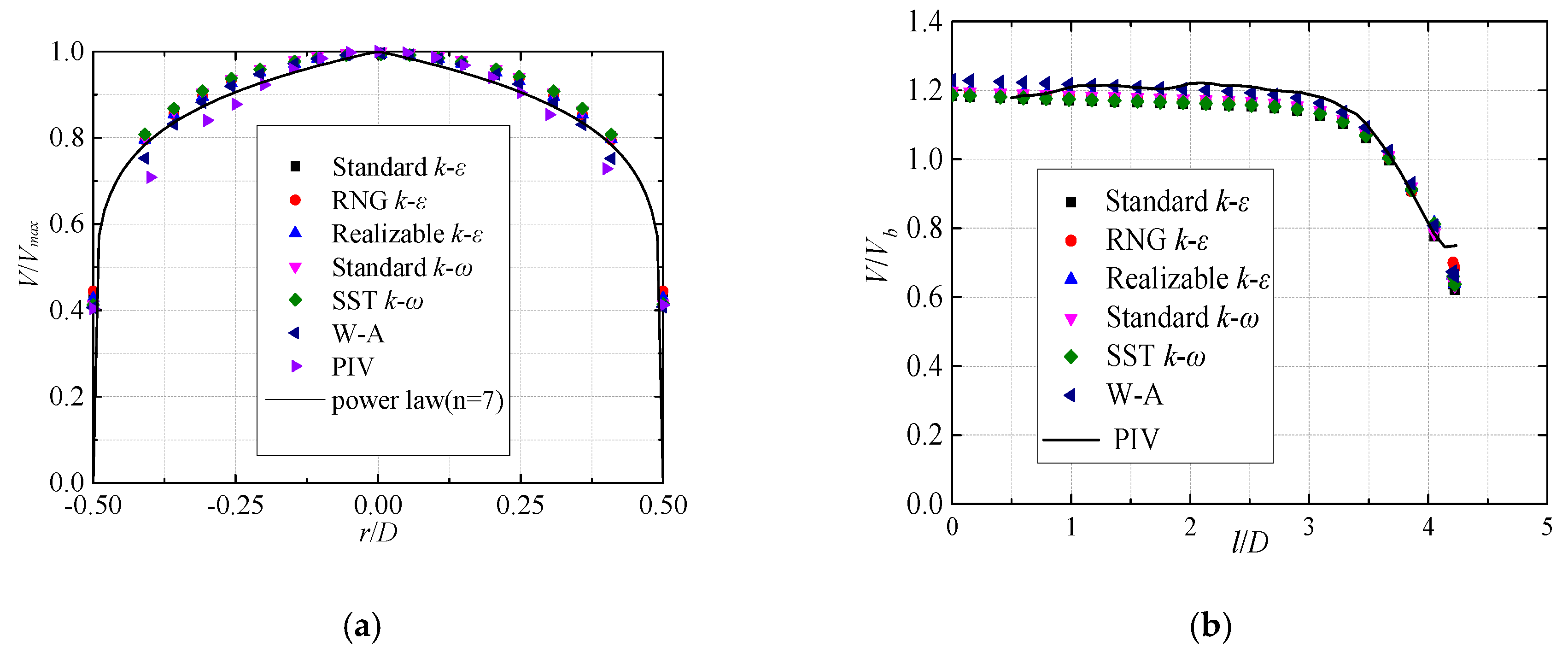
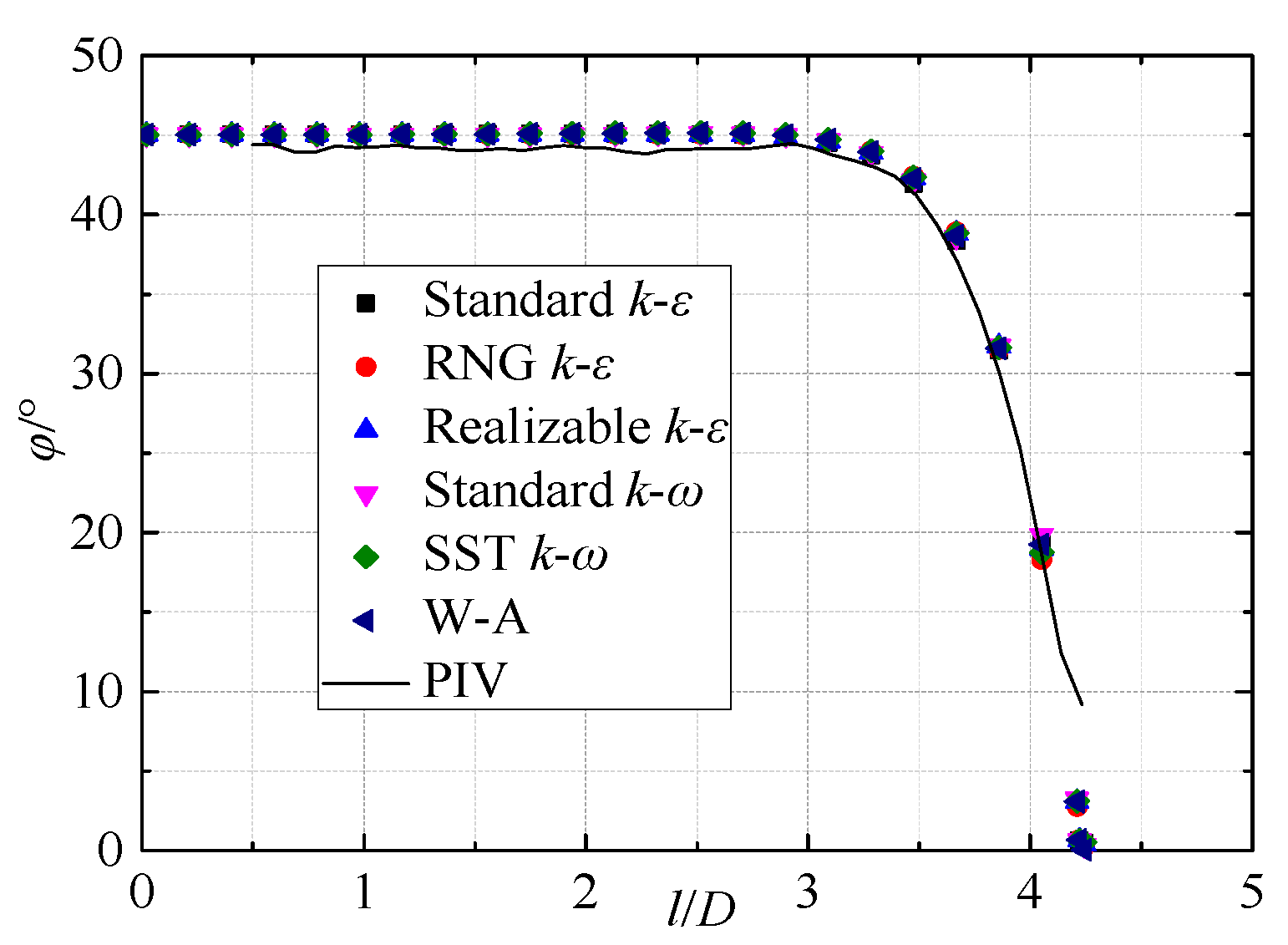
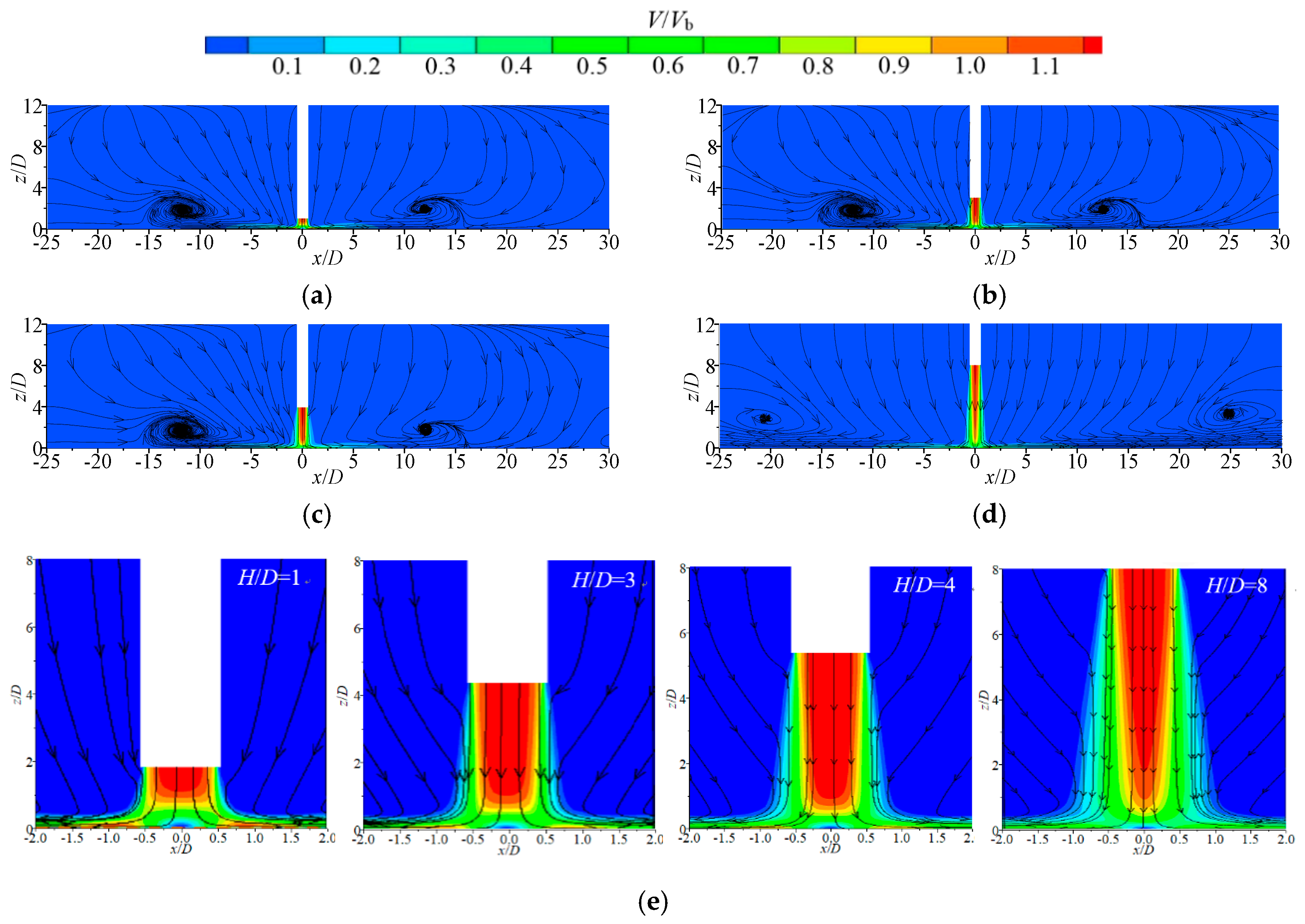
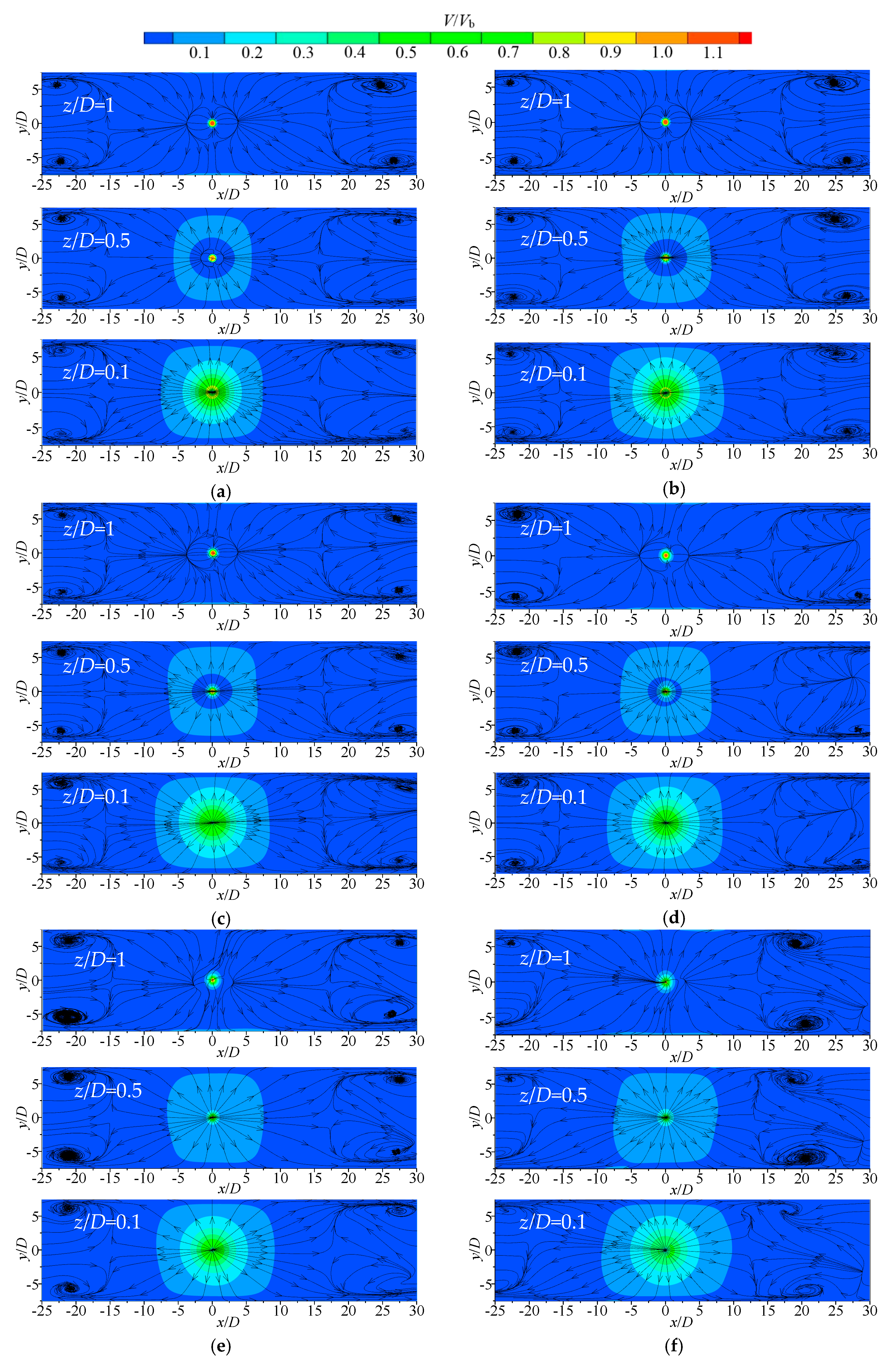
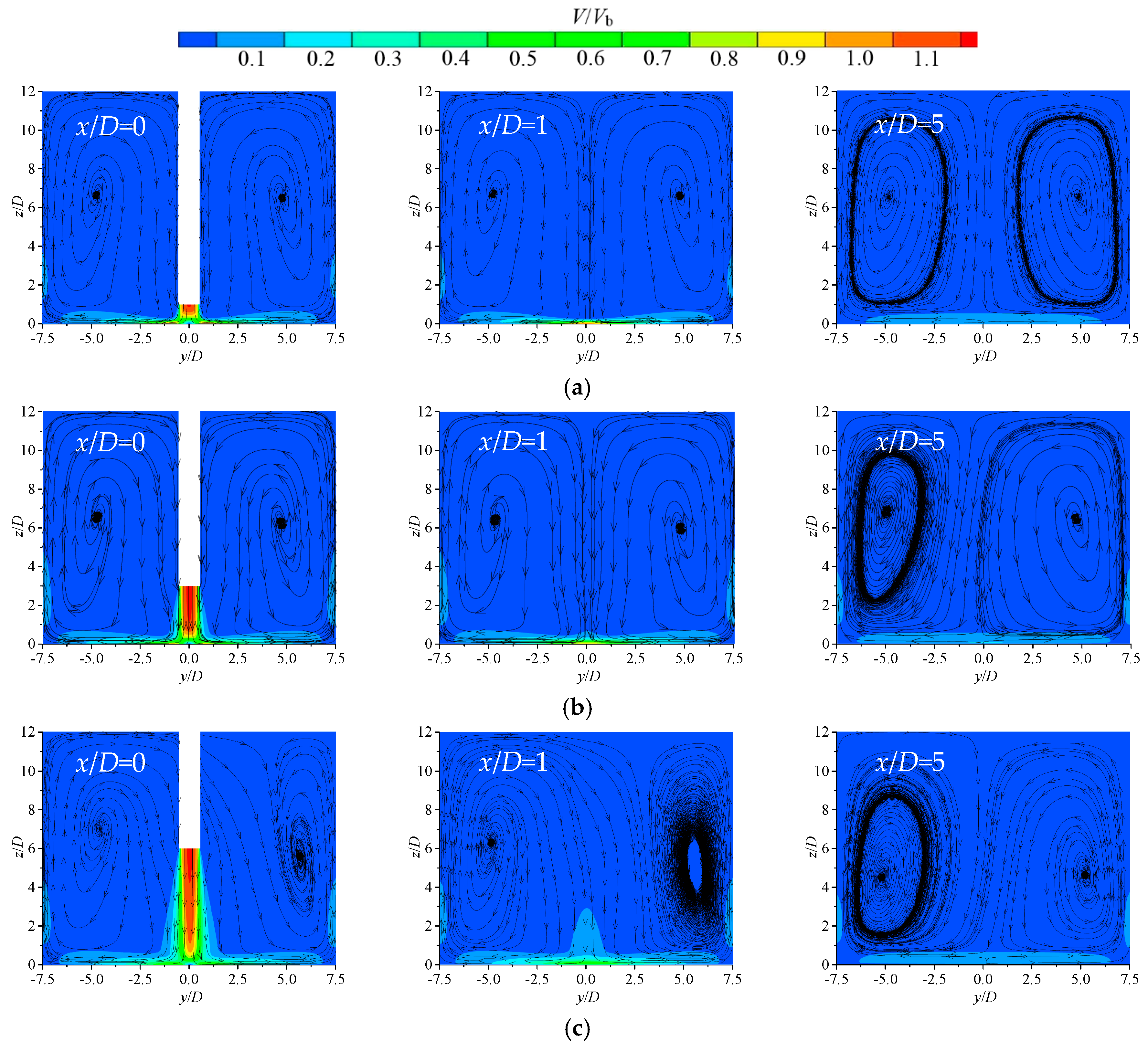
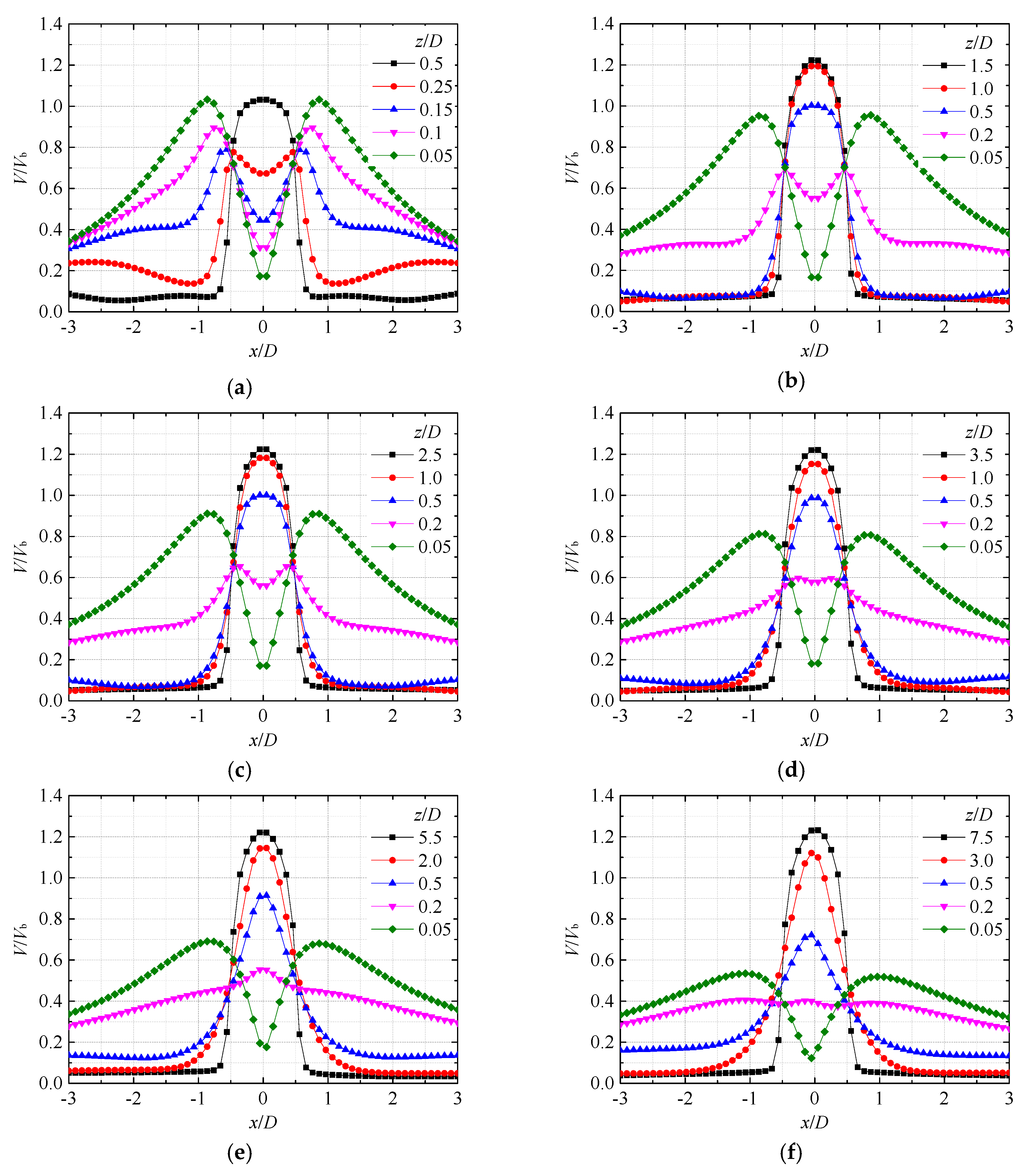
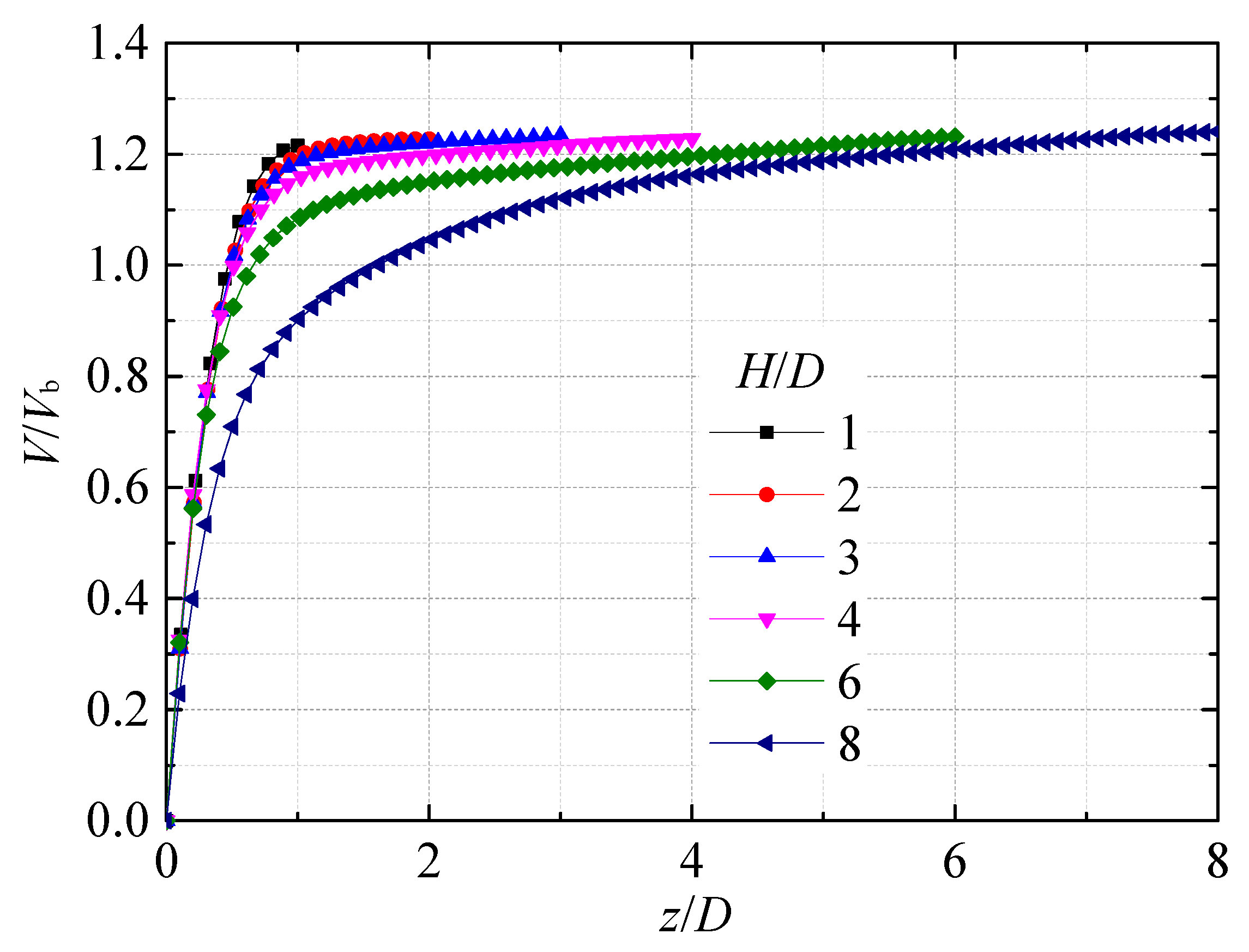


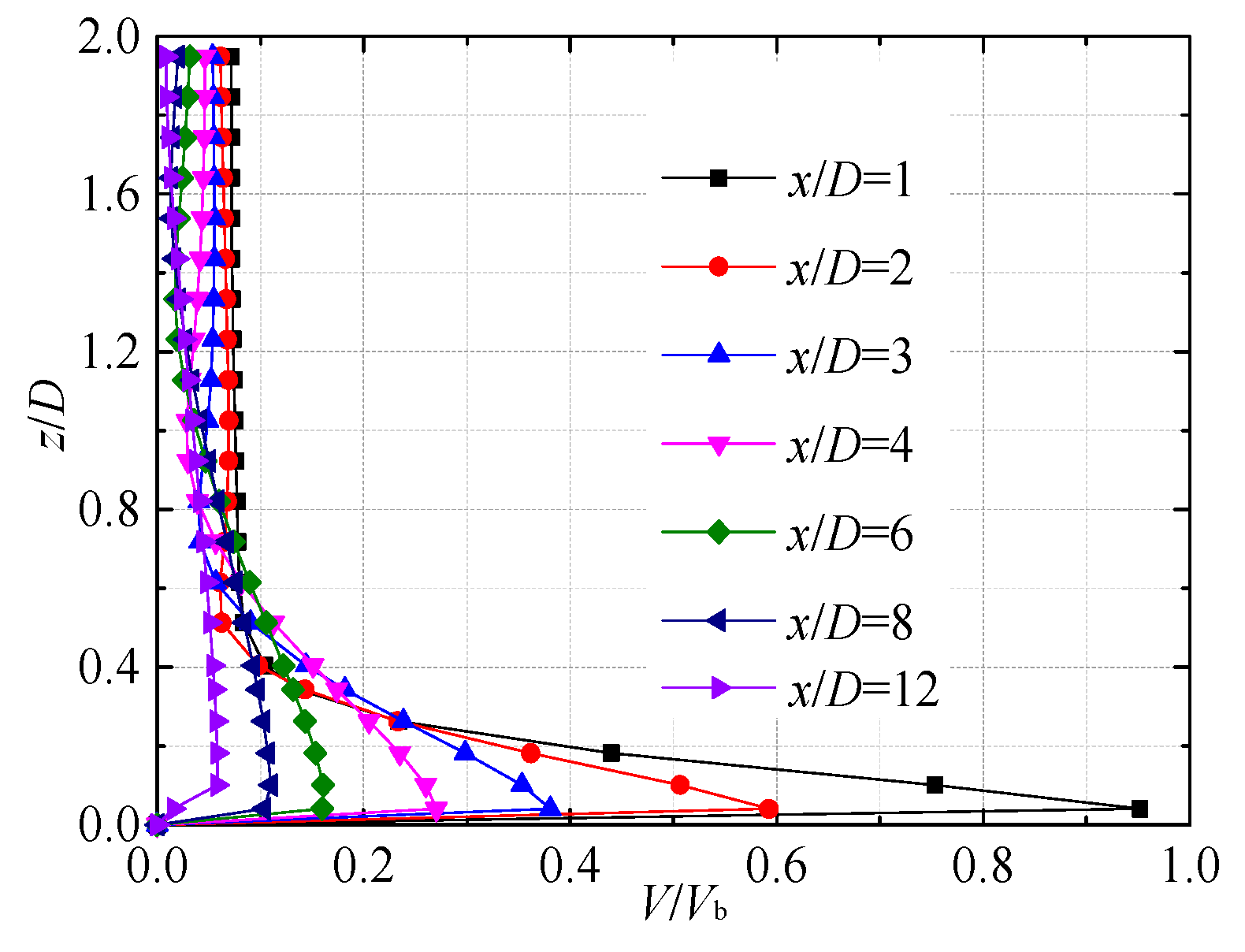

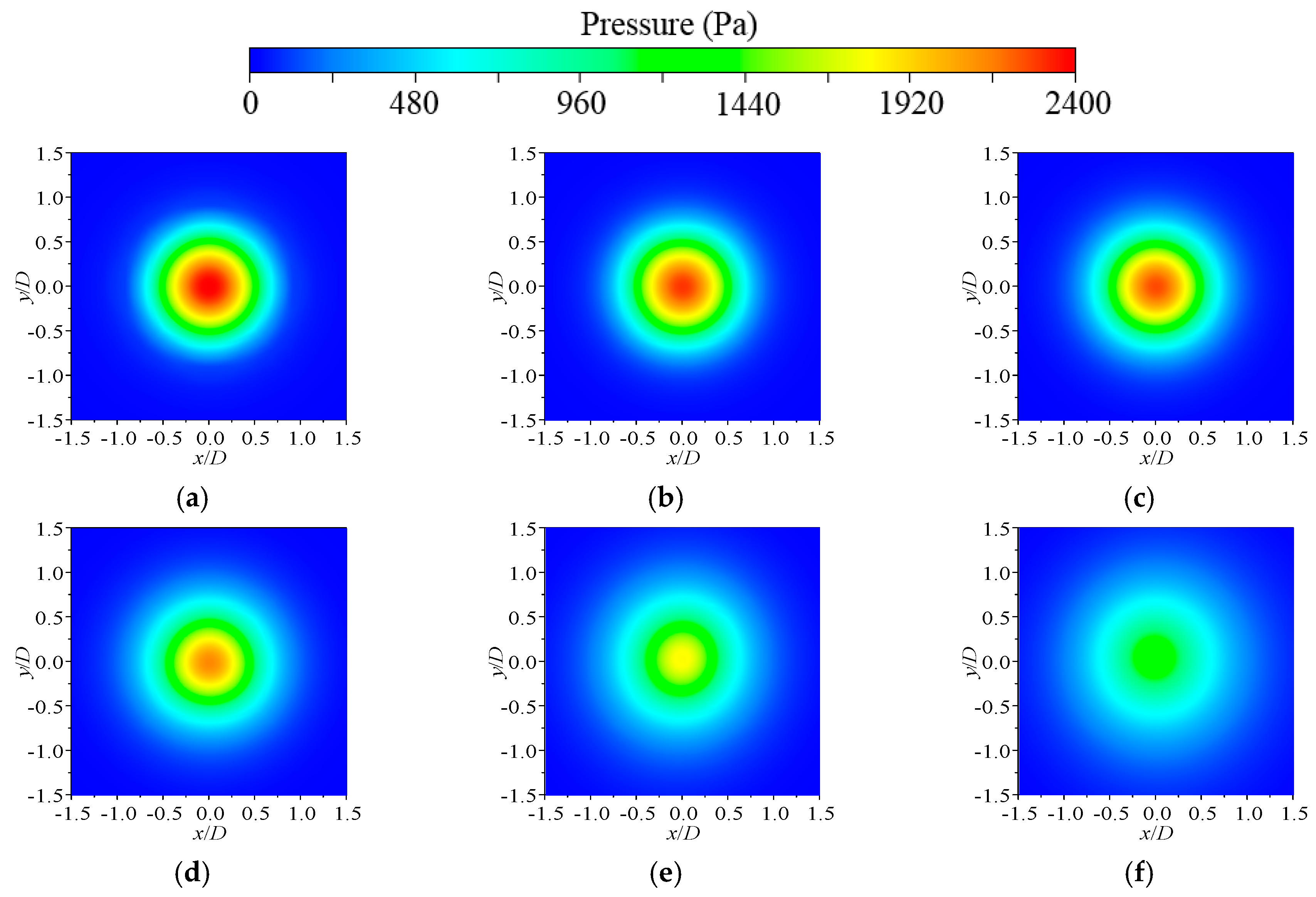



| Parameters | Condition 1 | Condition 2 | Condition 3 |
|---|---|---|---|
| Inlet velocity(m/s) | 0.585 | 1.17 | 1.76 |
| Re | 11,700 | 23,400 | 35,100 |
© 2020 by the authors. Licensee MDPI, Basel, Switzerland. This article is an open access article distributed under the terms and conditions of the Creative Commons Attribution (CC BY) license (http://creativecommons.org/licenses/by/4.0/).
Share and Cite
Wang, H.; Qian, Z.; Zhang, D.; Wang, T.; Wang, C. Numerical Study of the Normal Impinging Water Jet at Different Impinging Height, Based on Wray–Agarwal Turbulence Model. Energies 2020, 13, 1744. https://doi.org/10.3390/en13071744
Wang H, Qian Z, Zhang D, Wang T, Wang C. Numerical Study of the Normal Impinging Water Jet at Different Impinging Height, Based on Wray–Agarwal Turbulence Model. Energies. 2020; 13(7):1744. https://doi.org/10.3390/en13071744
Chicago/Turabian StyleWang, Hongliang, Zhongdong Qian, Di Zhang, Tao Wang, and Chuan Wang. 2020. "Numerical Study of the Normal Impinging Water Jet at Different Impinging Height, Based on Wray–Agarwal Turbulence Model" Energies 13, no. 7: 1744. https://doi.org/10.3390/en13071744
APA StyleWang, H., Qian, Z., Zhang, D., Wang, T., & Wang, C. (2020). Numerical Study of the Normal Impinging Water Jet at Different Impinging Height, Based on Wray–Agarwal Turbulence Model. Energies, 13(7), 1744. https://doi.org/10.3390/en13071744





